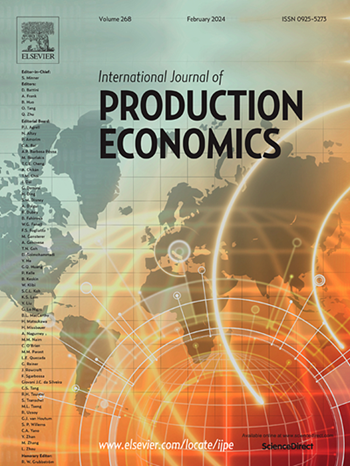Diffusion of digital transformation initiatives in multi-tier supply chains: The double agency role of Tier-1 suppliers
IF 10
1区 工程技术
Q1 ENGINEERING, INDUSTRIAL
引用次数: 0
Abstract
Growing global supply chain complexity has generated interest in multi-tier management, yet most research focuses on focal firm and Tier–1 ties, overlooking Tier-2 dynamics. A specific gap exists in investigating Digital Transformation Initiatives (DTI) within triadic relationships among the focal firm and its Tier-1 and Tier-2 suppliers. This study addresses this gap by utilizing a multiple-case study approach across diverse sectors, drawing on 30 interviews, to examine the diffusion of DTI across multi-tier supply chains, with particular attention to the Double Agency Role (DAR) of Tier-1 suppliers. Using social capital theory and agency theory, our findings emphasize the key role of social capital in the DAR of Tier-1 suppliers. The importance of relational and cognitive capital varies as we shift from downstream to upstream segments of the supply chain. Relational capital is crucial in the downstream segment (focal firm–Tier-1 supplier), while cognitive capital grows in significance as we move upstream (Tier-1–Tier-2 suppliers). Additionally, we create a matrix to illustrate the relationships among social capital, the DAR, and the effectiveness of DTI diffusion. This study contributes to the digital transformation literature by expanding its focus from dyadic to triadic relationships. It also offers practical implications for supply chain managers, providing actionable insights to enhance the diffusion of DTI.
数字化转型举措在多层供应链中的扩散:一级供应商的双重代理角色
日益增长的全球供应链复杂性引起了人们对多层管理的兴趣,但大多数研究都集中在焦点公司和一级关系上,而忽略了二级动态。在重点公司及其一级和二级供应商之间的三元关系中,调查数字化转型计划(DTI)存在特定的差距。本研究通过利用跨不同部门的多案例研究方法,利用30个访谈,来研究DTI在多层供应链中的扩散,特别关注一级供应商的双重代理角色(DAR),从而解决了这一差距。运用社会资本理论和代理理论,我们的研究结果强调了社会资本在一级供应商DAR中的关键作用。关系资本和认知资本的重要性随着我们从供应链的下游转移到上游而变化。关系资本在下游部分(焦点公司-一级供应商)至关重要,而认知资本随着我们向上游移动(一级-二级供应商)而变得越来越重要。此外,我们创建了一个矩阵来说明社会资本、DAR和DTI扩散有效性之间的关系。本研究通过将其重点从二元关系扩展到三元关系,为数字化转型文献做出了贡献。它也为供应链管理者提供了实际的启示,为提高DTI的传播提供了可操作的见解。
本文章由计算机程序翻译,如有差异,请以英文原文为准。
求助全文
约1分钟内获得全文
求助全文
来源期刊
CiteScore
21.40
自引率
7.50%
发文量
266
审稿时长
52 days
期刊介绍:
The International Journal of Production Economics focuses on the interface between engineering and management. It covers all aspects of manufacturing and process industries, as well as production in general. The journal is interdisciplinary, considering activities throughout the product life cycle and material flow cycle. It aims to disseminate knowledge for improving industrial practice and strengthening the theoretical base for decision making. The journal serves as a forum for exchanging ideas and presenting new developments in theory and application, combining academic standards with practical value for industrial applications.

 求助内容:
求助内容: 应助结果提醒方式:
应助结果提醒方式:


